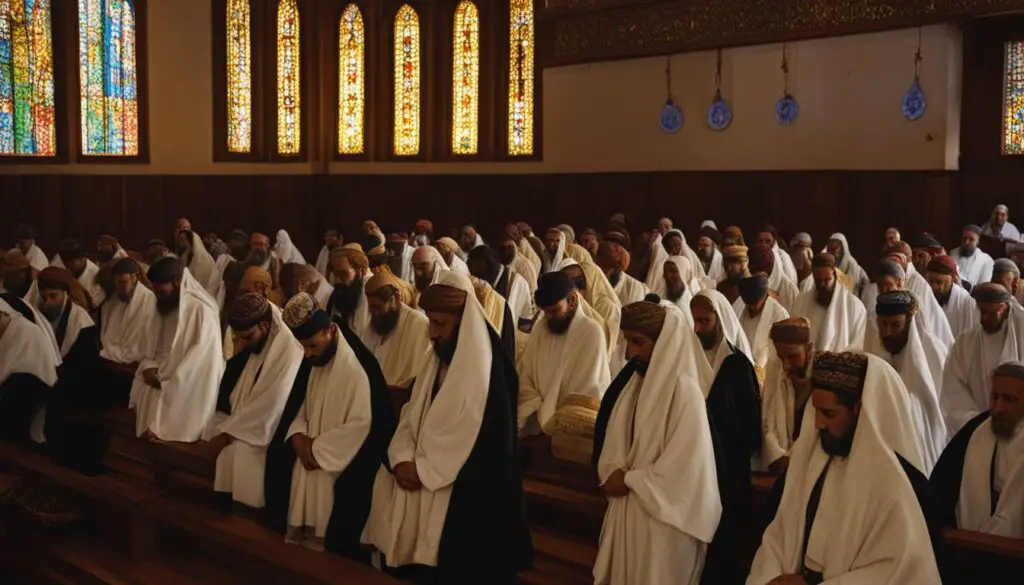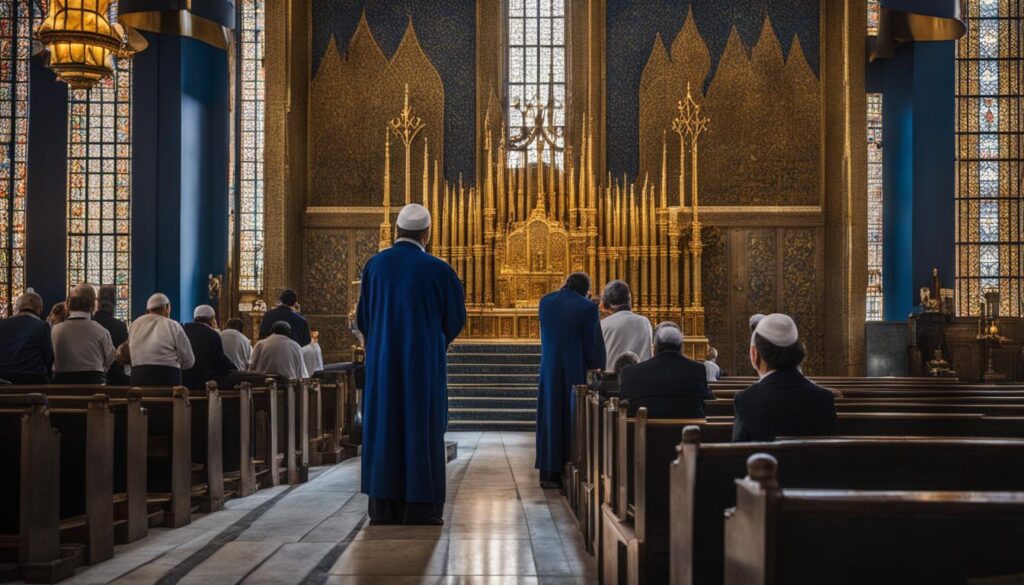The Amidah, also known as the Shemoneh Esreh, is the central prayer of the Jewish liturgy. It is recited three times a day, and on Shabbat, Rosh Chodesh, and Jewish festivals, additional Amidah prayers are recited. The Amidah is believed to have been composed by the rabbis of the Anshei Knesset HaGedolah and is a mitzvah de-rabbanan, a commandment of rabbinic origin. The Amidah consists of nineteen blessings, with the first three blessings focused on praising God, the middle thirteen blessings consisting of personal and communal requests, and the final three blessings expressing gratitude to God.
Key Takeaways:
- The Amidah is the central prayer of the Jewish liturgy.
- It is recited three times a day, with additional prayers on special occasions.
- The Amidah consists of nineteen blessings, expressing praise, requests, and gratitude to God.
- It was composed by the rabbis of the Anshei Knesset HaGedolah and is a rabbinic commandment.
- The Amidah holds deep spiritual significance in Jewish worship and provides a framework for connection with the divine.
The Structure of the Amidah Prayer
The Amidah prayer, also known as the Shemoneh Esreh, is structured into three main sections: praise, requests, and thanksgiving. This structure allows for a comprehensive and balanced approach to connecting with God and expressing one’s devotion. Let’s delve deeper into each section:
Praise
The first three blessings of the Amidah, known as the shevach, are dedicated to praising God. These blessings highlight God’s holiness, mention the biblical patriarchs, and acknowledge the divine power and greatness. By starting the Amidah with praise, worshippers set the tone for their prayer, recognizing God’s majesty before presenting their personal requests.
Requests
The middle thirteen blessings, known as the bakashah, form the core of the Amidah prayer. These blessings encompass personal and communal requests, covering a wide range of topics such as knowledge, repentance, forgiveness, healing, and prosperity. The structure of the bakashah blessings allows individuals to bring their specific needs before God, seeking guidance, support, and blessings for themselves and their community.
Thanksgiving
The final three blessings of the Amidah, known as the hoda’ah, are expressions of gratitude to God. These blessings acknowledge God’s continuous presence, appreciate His role as the ultimate source of sustenance and salvation, and pray for the restoration of the Temple worship. The hoda’ah blessings serve as a reminder to always be grateful and mindful of God’s blessings in one’s life.
The structure of the Amidah prayer provides a framework for worshippers to engage in a meaningful and comprehensive dialogue with God. It encourages the balance between praising, requesting, and expressing gratitude, reflecting the rich spiritual tradition of Judaism.
The Origins and History of the Amidah Prayer
The Amidah prayer has a rich history that dates back to the Second Temple period in ancient Israel. It is believed to have been composed by the rabbis of the Great Assembly, a group of Jewish sages who lived during the fifth century BCE. The Amidah prayer was originally recited in place of the daily tamid sacrifices that took place in the Temples in Jerusalem. After the destruction of the Second Temple, the Amidah became a central prayer in Jewish worship, and its recitation times were based on the times of the tamid sacrifices. Since then, the Amidah has undergone further development and additions, reflecting the changing needs and beliefs of the Jewish community throughout history.
The Amidah prayer holds immense significance in Judaism and is considered a mitzvah, a commandment from God. It is recited multiple times a day and is an opportunity for individuals to connect with God, express their praises, and make personal and communal requests. The historical origins of the Amidah prayer serve as a reminder of the deep roots of Jewish faith and the enduring nature of Jewish worship practices. It is a prayer that has been passed down through generations, connecting Jewish worshippers across time and space.
Throughout history, the Amidah has played a vital role in Jewish life, providing a framework for prayer and spiritual connection. It has evolved alongside the Jewish community, incorporating new blessings and themes to address the needs and concerns of different generations. The Amidah prayer continues to be a central element of Jewish worship, offering a sacred space for individuals to seek solace, guidance, and gratitude in their relationship with God.

| Amidah Prayer | Significance |
|---|---|
| Ancient Origins | Originated in the Second Temple period and was likely composed by the rabbis of the Great Assembly. |
| Connection to Sacrifices | Originally recited in place of the daily tamid sacrifices in the Temples in Jerusalem. |
| Continuity and Connection | Connects Jewish worshippers across time and space, creating a sense of unity and continuity. |
| Evolution and Expansion | Has evolved over time to incorporate new blessings and themes that reflect the changing needs and beliefs of the Jewish community. |
| Spiritual Connection | Provides a sacred space for individuals to connect with God, express praises, make requests, and offer gratitude. |
The Significance of the Amidah Prayer
The Amidah holds profound significance in Jewish prayer. It serves as a way for individuals to connect with God, express their praise, make personal and communal requests, and express gratitude. The Amidah can also be a form of meditation, providing a space for individuals to focus their thoughts and intentions on the divine. Additionally, the Amidah includes a specific prayer for healing, where individuals can offer prayers for themselves or others who are sick or in need of healing.
The Amidah prayer for healing is a powerful and meaningful aspect of the Amidah. It allows individuals to bring their physical, emotional, and spiritual needs before God, seeking comfort, strength, and restoration. Whether offering prayers for oneself or on behalf of others, the Amidah prayer for healing acknowledges the inherent connection between body, mind, and spirit, and the importance of holistic well-being. It is a reminder that God is a source of healing and a compassionate presence in times of illness and suffering.
Furthermore, the Amidah prayer provides a space for deep reflection and personal introspection. As individuals recite each blessing, they have the opportunity to delve into their own thoughts and feelings, examining their intentions, desires, and challenges. The Amidah can be a transformative experience, allowing individuals to cultivate a sense of inner peace, clarity, and connection with the divine. In this way, the Amidah prayer becomes a spiritual practice that nurtures the soul and fosters personal growth.
The Amidah Prayer for Healing
One of the most significant aspects of the Amidah prayer is the inclusion of a special blessing for healing. This prayer, known as Refaenu, asks God to bring healing to those who are ill, both physically and spiritually. It is a moment to offer prayers for oneself, loved ones, and even the broader community. The Amidah prayer for healing acknowledges the human need for physical and emotional well-being and seeks God’s intervention in times of illness and suffering.
| Blessing | Translation | Purpose |
|---|---|---|
| Refuah Shleimah | Complete Healing | To ask for physical and spiritual healing for oneself |
| Refuah Shleimah | Complete Healing | To ask for physical and spiritual healing for loved ones |
| Rifaeinu Adonai | Heal Us, O Lord | To pray for the healing of the broader community and the world |
The Amidah prayer for healing provides a powerful and comforting framework for individuals to seek solace, support, and restoration. It is a reminder of the healing power of prayer and the belief in God’s ability to bring healing to the body and the soul. Through this prayer, individuals can express their vulnerability, hope, and trust in God’s loving presence, finding strength and comfort in their faith.
The Amidah Prayer in Hebrew
The Amidah prayer is traditionally recited in Hebrew, the sacred language of the Jewish people. This ancient language carries deep historical and spiritual significance, allowing individuals to connect with the rich traditions and meanings associated with the Amidah. By reciting the Amidah in Hebrew, worshippers are able to participate in a timeless practice that has been passed down through generations, creating a sense of unity and continuity within the Jewish community.
When reciting the Amidah in Hebrew, individuals can fully immerse themselves in the profound words and intentions of the prayer. Each Hebrew word and phrase holds a unique significance, conveying layers of meaning that may be lost in translation. By engaging with the Amidah in its original language, worshippers can tap into the deep spiritual wellspring that Hebrew offers, enhancing their connection to God and their Jewish identity.
“The Amidah prayer, when recited in Hebrew, allows us to tap into the spiritual energy and wisdom of our ancestors. The precise choice of words and the cadence of the Hebrew language create a unique experience that can be transformative.”
While some communities may offer the option to recite the Amidah in other languages to promote inclusivity, the use of Hebrew remains central to the tradition and practice of the Amidah prayer. It is through the recitation of the Amidah in Hebrew that Jewish worshippers can fully engage with the prayer’s historical and spiritual significance, fostering a deep connection to their faith and heritage.

The Role of the Amidah in Jewish Worship
The Amidah prayer holds a central role in Jewish worship, serving as a cornerstone of daily, weekly, and holiday prayer services. It is recited three times a day during the morning (Shacharit), afternoon (Mincha), and evening (Ma’ariv) prayer services. Additionally, on Shabbat, Rosh Chodesh, and Jewish festivals, additional Amidah prayers are recited to commemorate and celebrate these special occasions.
During communal worship, the Amidah is recited twice, once silently by individuals and then repeated aloud by the prayer leader, known as the chazzan. This repetition allows for full participation and engagement of the entire congregation, who respond with “Amen” after each blessing. By reciting the Amidah together, the Jewish community creates a collective and unified connection with God.
The Amidah is not only a communal prayer but also a personal one. It provides individuals with a sacred space to express their praises, make personal requests, and express gratitude to God. Through the Amidah, Jews can connect with their faith, deepen their relationship with the divine, and seek guidance, comfort, and inspiration in their lives.

The Importance of the Amidah in Jewish Worship
The Amidah is a vital component of Jewish worship as it allows for both communal and individual expressions of faith. It provides a structured framework for prayer, allowing worshippers to engage with the divine, reflect on their intentions, and connect with generations of Jewish worshippers who have recited the Amidah throughout history.
The repetition of the Amidah during communal worship ensures that every member of the congregation can fulfill their obligation of prayer, even if they are unable to recite the Amidah themselves. It fosters a sense of unity and inclusivity within the Jewish community, as everyone joins together in prayer, responding with “Amen” to affirm each blessing.
Overall, the Amidah prayer serves as a fundamental aspect of Jewish worship, providing a meaningful and profound means of connecting with God, expressing devotion, and seeking spiritual guidance. Its presence in daily, weekly, and holiday prayer services ensures that the Amidah remains a central and cherished practice in Judaism.
Customs and Practices Associated with the Amidah Prayer
The recitation of the Amidah prayer is accompanied by various customs and practices that enhance the spiritual experience and reverence associated with this central prayer in Judaism.
Standing with Feet Together
One of the customs associated with the Amidah is standing with feet firmly together. This posture signifies respect and focus during prayer and serves as a physical manifestation of unity and connection with God. By standing with feet together, worshippers demonstrate their readiness to engage in conversation with the divine.
Facing Jerusalem or the Ark
It is customary to face Jerusalem or the direction of the Ark where the Torah is kept while reciting the Amidah. This practice symbolizes the centrality of Jerusalem in Jewish history and spirituality. It also serves as a reminder of the connection between the Jewish people and the land of Israel.
Quiet and Focused Recitation
During the Amidah, it is customary to recite the prayer quietly but audibly for oneself. This quiet recitation allows for personal reflection and concentration, enabling individuals to connect deeply with the words and intentions of the prayer. It is considered a conversation with God, and therefore interruptions, even greetings, are generally avoided.
Physical Movements and Bowing
The Amidah includes specific physical movements and bowing at certain points during the prayer. For example, worshippers often begin and end each blessing by bending their knees and bowing. There are also moments when individuals take three steps backward and forward, symbolizing the approach to and departure from the divine presence. These physical movements add a sense of reverence and intentionality to the recitation of the Amidah.
Personal Prayers and Requests
While the Amidah has a fixed structure and set prayers, there is also room for individuals to insert their own personal prayers and requests within the prayer. This allows worshippers to express their individual needs, concerns, and gratitude to God. Common personal prayers within the Amidah include prayers for healing, strength, guidance, and blessings for specific individuals.
By engaging in these customs and practices associated with the Amidah prayer, individuals create a sacred space for worship, introspection, and connection with the divine. These traditions not only enhance the spiritual experience but also foster a sense of unity and continuity among Jewish worshippers throughout history.
The Role of the Chazzan in the Amidah Prayer
In communal worship, the chazzan, or prayer leader, plays a vital role in guiding the congregation through the recitation of the Amidah prayer. The chazzan’s responsibilities include leading the congregation in both the silent and audible recitation of the prayer, ensuring that everyone fulfills their obligation of prayer. The chazzan’s repetition of the Amidah allows for active participation and engagement of the entire congregation, who respond with “Amen” after each blessing.
During the chazzan’s repetition of the Amidah, special prayers and additions may be incorporated, such as the Kedushah, which proclaims the holiness of God. These additions add depth and significance to the worship experience, enhancing the spiritual connection between the congregation and the divine. The chazzan’s role extends beyond reciting the Amidah, as they often lead other parts of the prayer service, such as the Torah reading and the chanting of other liturgical texts.
The presence of a chazzan in the recitation of the Amidah strengthens the communal aspect of Jewish worship. The chazzan’s knowledge of the prayer and their ability to lead with clarity and reverence allow the congregation to follow along and engage fully in the worship experience. The chazzan’s role is not only to recite the prayer on behalf of the congregation but also to inspire and uplift through their tone, cadence, and personal connection with the words of the Amidah.

The Chazzan’s Role in Congregational Prayer
The chazzan serves as a spiritual guide in congregational prayer, helping to maintain the integrity of the Amidah and creating an atmosphere conducive to meaningful worship. Their role extends beyond mere recitation, as they lead the congregation in expressing their devotion, praise, and supplication. The chazzan’s presence adds a layer of reverence and authority to the Amidah prayer, elevating it to a communal experience that fosters unity, connection, and spiritual growth.
The chazzan’s years of training, knowledge of the liturgy, and understanding of the meaning behind the words of the Amidah allow them to lead with confidence and authenticity. By setting the tone and pace of the prayer, the chazzan sets the stage for a collective experience of reverence and devotion. Their role is not to overshadow or dominate the prayer but to facilitate and guide the congregation towards a deeper connection with God.
The Importance of a Skilled Chazzan
A skilled chazzan brings a wealth of knowledge and expertise to the recitation of the Amidah prayer. They possess a deep understanding of the nuances and melodies associated with the prayer, creating a musical and soul-stirring experience. A talented chazzan can use their voice to evoke emotions, transcend barriers, and inspire spiritual transformation within the congregation.
Having a proficient chazzan ensures that the Amidah prayer is recited with the proper intention, pronunciation, and cadence. They act as a conduit between the congregation and the divine, leading the way in the congregation’s spiritual journey. A skilled chazzan has the ability to captivate the congregation’s attention, helping them to fully immerse themselves in the timeless words of the Amidah and connect with the divine presence.
Variations in the Amidah Prayer
The Amidah prayer, also known as the Shemoneh Esreh, is a central and revered prayer in Jewish worship. While the structure and content of the Amidah are generally consistent, there are some variations based on different occasions and holidays. These variations allow for the prayer to reflect the specific themes and significance of each occasion, further enriching the worship experience.
Shabbat and Holidays
On Shabbat and holidays, the Amidah prayer is modified to align with the sanctity and celebration of these special days. The middle section of the Amidah, known as the bakashah, is adjusted to emphasize the holiness and joy of the occasion. The prayers may include specific references to the themes and traditions associated with Shabbat or the particular holiday being observed. These modifications enhance the spiritual connection and communal experience of worship during these significant times.
Fast Days
On fast days, such as Yom Kippur or Tisha B’Av, the Amidah may include additional prayers and modifications to reflect the somber and introspective nature of the day. These additions provide an opportunity for individuals to express their repentance, seek forgiveness, and reflect on the historical events and lessons associated with the respective fast day. The Amidah on fast days serves as a solemn reminder of the importance of self-reflection, atonement, and spiritual growth.
Customs and Traditions
Individual Jewish communities may have slight variations in their recitation of the Amidah based on their specific customs and traditions. These variations can include different melodies, the inclusion of additional prayers or personal supplications, and even variations in the specific wording of certain blessings. These customs and traditions add depth and richness to the worship experience, allowing for a diverse tapestry of Jewish prayer practices.
| Variations in the Amidah Prayer | Description |
|---|---|
| Shabbat and Holidays | Modified to align with the sanctity and celebration of Shabbat and holidays, emphasizing specific themes and traditions. |
| Fast Days | Includes additional prayers and modifications to reflect the somber and introspective nature of fast days, providing an opportunity for repentance and reflection. |
| Customs and Traditions | Variations in recitation based on specific customs and traditions of individual Jewish communities, adding depth and diversity to the worship experience. |
The variations in the Amidah prayer allow for a dynamic and adaptable worship experience, connecting individuals to the unique significance of each occasion and fostering a deeper spiritual connection. These variations, whether on Shabbat, holidays, fast days, or influenced by customs and traditions, contribute to the vibrancy and richness of Jewish prayer and ensure its continued relevance in contemporary Jewish life.

The Significance of the Amidah Prayer in Jewish Life
The Amidah prayer plays a significant role in Jewish life and serves as a powerful expression of faith, devotion, and connection to God. It is a time for individuals to express their praises, make personal requests, and express gratitude. The Amidah is a central part of daily, weekly, and holiday worship, creating a sense of unity and continuity among Jewish communities. Its structure and content have been passed down through generations, connecting individuals to the rich history, traditions, and spiritual depth of Judaism.
The Amidah is not just a set of words to be recited, but a deeply meaningful prayer that embodies the core values and beliefs of Judaism. It provides a space for individuals to commune with God, seeking guidance, strength, and solace.
The Amidah prayer, with its roots in ancient times, continues to be relevant in the lives of Jewish individuals today. It offers a framework for spiritual reflection, introspection, and connection with the divine. Through the recitation of the Amidah, Jews are able to deepen their relationship with God and find inspiration for their daily lives. The Amidah also serves as a form of meditation, allowing individuals to focus their thoughts and intentions on each specific blessing.
The Power of Uniting in Prayer
The Amidah holds particular significance when recited communally. When a congregation comes together to recite the Amidah, there is a sense of collective connection and shared purpose. The repetition of the Amidah by the prayer leader allows for full participation and engagement of the entire congregation. This shared experience strengthens the bonds within the community and reinforces the collective faith and commitment to Jewish traditions.
Additionally, the Amidah prayer provides a platform for individuals to insert personal prayers and requests. This personalized aspect of the Amidah allows for individual experiences and needs to be acknowledged within the larger context of the prayer. Whether it is a prayer for healing, strength, or guidance, the Amidah provides a space for individuals to express their deepest desires and connect with God on a personal level.
Overall, the Amidah prayer holds great significance in Jewish life, providing a profound opportunity for spiritual connection, reflection, and communal unity.
The Spiritual Relevance of the Amidah Prayer Today
The Amidah prayer continues to hold spiritual significance in the lives of Jewish individuals today. It serves as a profound way for individuals to connect with the divine, offering a space for reflection, introspection, and deepening their relationship with God. As the Amidah is recited, individuals can find solace, guidance, and inspiration, allowing their thoughts and intentions to align with each specific blessing.
Through the recitation of the Amidah, many Jews experience a sense of unity and spiritual elevation. The physical practices associated with the Amidah, such as standing, bowing, and reciting prayers in unison, create a sacred atmosphere and enhance the worship experience. The repetition of the Amidah by the chazzan adds a communal dimension, enabling the entire congregation to actively participate and respond with “Amen” after each blessing.
The Amidah prayer also provides a framework for meditation. By focusing their thoughts, intentions, and prayers on each specific blessing, individuals can enter a state of mindfulness and contemplation. This allows for a deeper connection with the divine and a heightened sense of spiritual awareness.
Table: Comparing the Amidah Prayer to Meditation
| Amidah Prayer | Meditation |
|---|---|
| Recited aloud or silently | Silent contemplation |
| Structured prayer with specific blessings | Flexible practice with no set structure |
| Focuses on connection with God and communal worship | Focuses on self-awareness and inner peace |
| Uses verbal and physical expressions | Relies on quiet reflection and stillness |
The Amidah prayer, with its historical significance and deep spiritual meaning, continues to be a cherished and impactful practice in Jewish life. It offers individuals a space to connect with God, engage in personal and communal reflection, and experience a sense of belonging and unity within the Jewish community. Whether reciting the Amidah silently or participating in its communal repetition, individuals find comfort, guidance, and spiritual elevation through this timeless prayer.
Conclusion
The Amidah is an integral part of Jewish prayer and holds great significance in Judaism. This central prayer, also known as the Shemoneh Esreh, is recited multiple times a day, providing a structured means of connecting with God.
Comprised of nineteen blessings, the Amidah encompasses praise, personal and communal requests, and expressions of gratitude. Its structure and content have been passed down through generations, connecting individuals to the rich history and traditions of Judaism.
Reciting the Amidah is not only a powerful act of faith and devotion, but it also serves as a pathway for spiritual growth and introspection. Through the words and actions of the Amidah, individuals can deepen their relationship with God and find solace, guidance, and inspiration.
As Jewish worshippers recite the Amidah, they join a long line of individuals who have sought connection, meaning, and fulfillment through this profound prayer. The Amidah prayer continues to be a cherished and cherished practice that nourishes the souls of Jewish communities worldwide.
FAQ
What is the Amidah prayer?
The Amidah, also known as the Shemoneh Esreh, is the central prayer of the Jewish liturgy. It is recited three times a day and consists of nineteen blessings.
Who composed the Amidah?
The Amidah is believed to have been composed by the rabbis of the Anshei Knesset HaGedolah, a group of Jewish leaders, and is a commandment of rabbinic origin.
What are the sections of the Amidah?
The Amidah prayer is structured into three main sections: praise, requests, and thanksgiving. The first three blessings focus on praising God, the middle thirteen blessings consist of personal and communal requests, and the final three blessings express gratitude to God.
How is the Amidah prayer recited?
The Amidah is traditionally recited while standing with feet firmly together, preferably facing Jerusalem. It is often recited silently as a personal prayer and then repeated aloud by the prayer leader during communal worship.
What is the significance of the Amidah prayer?
The Amidah prayer serves as a way for individuals to connect with God, express praise, make requests, and express gratitude. It holds historical and spiritual significance in Jewish prayer and worship.
Is the Amidah prayer recited in Hebrew?
Yes, the Amidah prayer is traditionally recited in Hebrew, the sacred language of the Jewish people. It allows for a deep connection to the ancient traditions and meanings associated with the prayer.
What are the customs and practices associated with the Amidah prayer?
Some customs include standing with feet together, facing Jerusalem or the Ark where the Torah is kept, and reciting the prayer quietly but audibly to oneself. There are also specific physical movements and bowing associated with certain parts of the Amidah.
What is the role of the chazzan in the Amidah prayer?
The chazzan, or prayer leader, leads and guides the congregation in the recitation of the Amidah prayer. The chazzan first recites the Amidah silently and then repeats it aloud for the congregation.
Are there variations in the Amidah prayer?
Yes, there are variations based on different occasions and holidays. On Shabbat and holidays, the Amidah is modified to focus on the holiness and celebration of these special days. Individual communities may also have slight variations based on their customs and traditions.
How is the Amidah prayer relevant in Jewish life?
The Amidah prayer plays a significant role in Jewish life, offering a means of personal and communal connection with God. It provides a space for reflection, introspection, and spiritual growth.
What is the spiritual relevance of the Amidah prayer today?
The Amidah prayer continues to hold spiritual relevance in the lives of Jewish individuals today. It serves as a powerful act of faith, devotion, and praise, allowing individuals to deepen their relationship with God.








